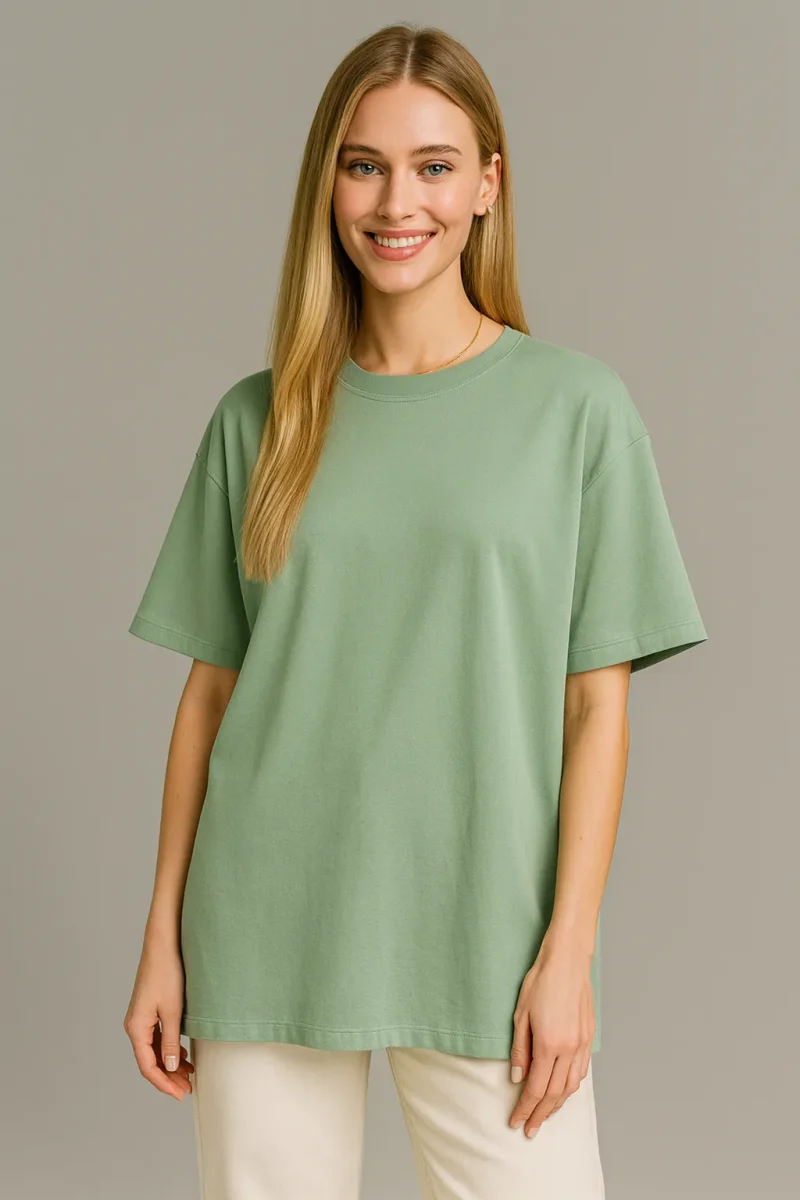
Understanding the True Cost of Making a T-shirt
When you decide to manufacture a t-shirt, whether for your own brand or as part of a custom order, one of the first questions that comes to mind is: How much does it cost to produce a t-shirt? The cost of making a t-shirt depends on several factors, including the quality of the material, the complexity of the design, and the quantity of t-shirts produced. In this article, we will break down all the aspects that influence the cost to produce a t-shirt, helping you understand how the T-shirt manufacturing cost is formed and which factors you can control to reduce costs.
Factors That Influence the Cost of T-shirt Production
T-shirt manufacturing involves a series of factors that determine the final price. These factors not only affect the price to make a custom shirt but also the overall profitability of your business. From material to customization and production volume, every aspect must be carefully considered to ensure that you get the best possible price without sacrificing quality.
Material Quality and Its Impact on Price
The type of material used is one of the most important factors in determining shirt production expenses. Cheaper materials, such as conventional cotton or synthetic blends, can significantly reduce costs, but more exclusive materials, like organic cotton or recycled fabrics, increase production prices. While the cost of making a custom t-shirt may be higher with premium materials, they provide added value to the consumer, which can justify the price increase. High-quality fabrics, such as combed cotton, also offer greater durability and comfort, which can be a long-term investment for brands.
Natural vs. Synthetic Fabrics: What’s the Price Difference?
Natural fabrics like cotton and linen generally cost more than synthetics like polyester, but they offer superior feel and durability. Consumers are willing to pay more for natural fabrics, which can justify the higher price of the final product.
Durability and Comfort: Why Premium Fabrics Cost More
Durability and comfort are factors that justify the cost of premium materials. High-quality fabrics like Egyptian cotton or Pima are softer and more durable, making them an attractive option for consumers looking for luxury products.
Labor Costs and Where You Produce Your T-shirts
The T-shirt manufacturing cost is also influenced by labor costs. If you decide to manufacture your t-shirts in a country with cheap labor, like certain regions of Asia, production costs will be lower. However, if you choose to produce in a location with higher labor costs, such as the United States or Europe, prices will rise. Additionally, the location of production affects other expenses, like transportation and logistics, which should also be considered in the shirt pricing guide. While offshore manufacturing is typically cheaper, it may lead to quality issues or delays in delivery times.
How Labor Laws Affect T-shirt Manufacturing Costs
Labor laws and wages in a country greatly influence the cost of t-shirt production. In countries with low wages, such as Bangladesh or India, labor costs are significantly lower, reducing the cost to produce a t-shirt. However, labor laws in these countries may be less stringent, which can affect the quality of the work.
The Hidden Costs of Overseas Manufacturing
Manufacturing overseas can reduce labor costs, but hidden costs such as international shipping, customs fees, and delays can affect profitability. It is important to take all of these costs into account when calculating the final T-shirt manufacturing cost.
The Role of Customization: Printing, Embroidery, and Special Finishes
Customization is another crucial factor when considering the cost of making a t-shirt. Cost to produce a t-shirt increases significantly when custom prints, embroidery, or special finishes are added. T-shirts with digital printing or embroidery require additional labor and the use of specialized equipment, raising the price. Moreover, the more complex the design or the number of colors used, the more expensive the customization process will be. Therefore, if you want to maintain control over costs, it’s advisable to go for a simple design or single-color printing.
Screen Printing vs. Direct-to-Garment (DTG) Printing Costs
Screen printing is more affordable in large volumes, but the cost to produce a t-shirt rises when the design includes multiple colors or intricate details. DTG printing, on the other hand, allows for high-quality prints but tends to be more expensive for large-scale productions.
The Price of Embroidering vs. Simple Stamping
Embroidery is generally more expensive than stamping due to the manual labor and specialized machinery required. While embroidery provides a high-quality appearance, the T-shirt manufacturing cost increases because of the additional time and materials involved.
How Material Choices Affect T-shirt Prices
Material choices not only affect the quality of the t-shirts but also the T-shirt manufacturing cost and consumer perception. Cheaper and more accessible materials, such as conventional cotton or polyester, are ideal for large-scale production where cost per unit is a priority. However, more sustainable and high-quality materials, such as organic cotton or bamboo, raise production costs. Still, these products may attract a specific market that values sustainability, justifying a higher price.
Organic Cotton vs. Conventional Cotton
The cost of making a custom t-shirt with organic cotton is higher due to the additional costs involved in its cultivation, such as sustainable farming methods that require more work and time. However, organic cotton t-shirts are typically softer and have a special appeal to environmentally conscious consumers. Despite the higher cost, organic cotton t-shirts can be a great long-term investment as they offer better durability and are perceived as higher-quality products.
- Benefits of Organic Cotton for Sustainability
Organic cotton is grown without pesticides or synthetic fertilizers, reducing the environmental impact. This makes t-shirts made from organic cotton more attractive to environmentally conscious consumers.
- How Cotton Prices Vary Globally
Cotton prices vary by country of origin. Cotton-producing countries like India and China can offer lower prices, but organic cotton produced in other regions tends to be more expensive due to lower supply and sustainable production methods.
Other Materials That Impact the Cost of Production
Cotton is not the only material used in t-shirt manufacturing. Synthetic fabrics, like polyester, tend to be cheaper due to their mass production and shorter manufacturing time. However, consumers are becoming increasingly aware of the environmental implications of synthetic materials, which can affect the perceived value of the product. If you decide to use materials like bamboo or hemp, they are typically more expensive but have a significantly lower environmental impact than conventional materials.
- Polyester and Blends: Why These Are Cheaper
Polyester and synthetic blends are cheaper than cotton because of their mass production and lower cultivation costs. These fabrics are ideal for producing affordable t-shirts but may not be as valued by consumers seeking sustainability. - Eco-friendly Materials: Bamboo, Hemp, and Their Costs
Materials like bamboo and hemp are gaining popularity due to their sustainability, but they are more expensive to produce than traditional materials. T-shirts made from these materials can justify a higher price due to their lower environmental impact.
Why Fabric Weight and Thickness Matter
Fabric quality, including the thickness and weight of the material, directly impacts T-shirt manufacturing cost. Heavier t-shirts, like those weighing 180-200 grams, are typically more expensive than lighter ones because they use more material. Furthermore, thicker fabrics are generally more durable and higher in quality, which can justify the added cost if marketed as premium t-shirts.
- Lightweight vs. Heavyweight: What Affects the Cost?
Lightweight t-shirts are more economical to produce, but heavyweight ones offer greater durability and a more luxurious feel. The production cost per t-shirt increases with fabric thickness.
- How Fabric Thickness Affects Durability and Price
Thicker fabrics tend to last longer, but they increase T-shirt manufacturing cost. Consumers looking for a more durable t-shirt will be willing to pay more, while those preferring lightweight and cheaper t-shirts might opt for less expensive products.
The Impact of Order Volume on T-shirt Production Costs
Order volume is a crucial factor in determining shirt production expenses. When you place large orders, production costs per unit decrease due to economies of scale. This means that if you can place a larger order, you can reduce the price to make a custom shirt and achieve higher profitability. However, if you only need a small number of t-shirts, the cost per unit is likely to be much higher due to smaller setup and production costs.
Why Bulk Orders Can Save You Money
Placing large orders generally reduces the cost of making a custom t-shirt per unit. This is because machine setup time is the same regardless of order size. Additionally, labor costs are spread across more units, reducing the final price. Manufacturers also tend to offer discounts on larger orders, making your investment more cost-effective.
- How Bulk Ordering Reduces Setup Costs
Setup costs for each order are fixed, so the higher the order volume, the lower the cost per unit. This makes bulk orders much more economical in terms of T-shirt manufacturing cost.
- How Production Time and Labor Costs Are Affected by Volume
As order volume increases, production time per unit decreases, reducing labor costs associated with producing each t-shirt.
Conclusion: Understanding the True Cost of Making a T-shirt
In conclusion, the cost to produce a t-shirt depends on a wide variety of factors ranging from material type to production volume and design customization. Each of these elements directly impacts the T-shirt manufacturing cost and, therefore, the final price of the product. While materials like organic
cotton or special finishes may increase the price to make a custom shirt, they also offer opportunities to create higher-value products that resonate with quality- and sustainability-conscious consumers.
Order volume also plays a crucial role in reducing unit costs, as large orders allow you to take advantage of economies of scale. Furthermore, choosing where to manufacture—whether offshore or locally—will influence shirt production expenses through factors like labor costs and shipping expenses.
Ultimately, understanding these aspects will allow you to make more informed decisions about how to optimize your production costs. While t-shirt manufacturing can be costly, having a good grip on the factors that impact production costs will help maximize your profit margins without compromising quality. By considering these key factors, you can strike the right balance between cost and quality, ensuring the profitability of your business and offering products that meet your customers’ expectations.
Share:
Most Popular


How to Create a Signature Look?

Minimalist Fashion for Men

Cotton vs polyester t-shirts
Related Posts

How To Build a Minimalist Wardrobe?
In a world flooded with fast fashion and cluttered closets, the minimalist wardrobe has become a refreshing alternative. It’s not

How to Create a Signature Look?
In a world overwhelmed with fast fashion, fleeting trends, and influencers setting new rules every week, establishing a signature look

Minimalist Fashion for Men
In a world driven by trends and consumerism, minimalist fashion has emerged as a bold yet quiet rebellion. For men,

Cotton vs polyester t-shirts
When shopping for t-shirts, one of the first choices you’ll face is the fabric — often cotton or polyester (or


